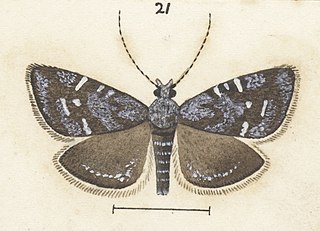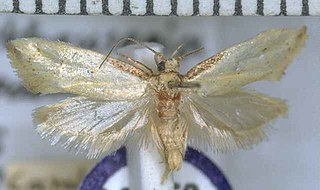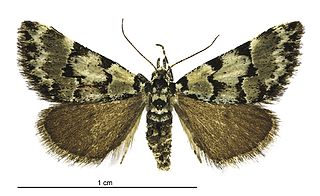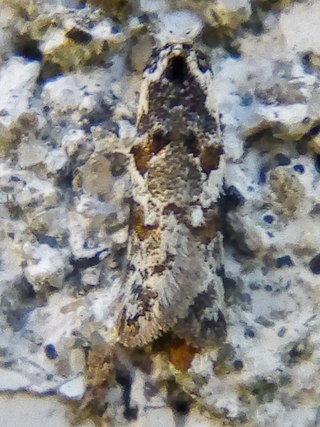
Cephalissa is a monotypic moth genus in the family Geometridae. Its only species, Cephalissa siria, the orange triangle moth, is endemic to New Zealand. This species has been classified as nationally vulnerable by the Department of Conservation. It has suffered a contraction of its range, no longer being seen in Dunedin or Invercargill. It is currently found in the Mt Watkin Scenic Reserve, in eastern Otago, in the Rongahere Gorge and in the Dansey Ecological District. C. siria is known to inhabit kahikatea forest amongst Carex species as well as short tussock grasslands and shrubland. The larval host plant is Fuchsia perscandens. Adult moths are on the wing in October and November.

Asterivora symbolaea is a species of moth in the family Choreutidae. It is endemic to New Zealand and has been observed in Arthur's Pass. This species lives in subalpine habitat. Adults of this is on the wing in January and February. Larvae are hosted by Celmisia prorepens.

Pyrgotis eudorana is a species of moth of the family Tortricidae. It is endemic in New Zealand and has been observed in both the North and South Islands. However it is regarded as a rare insect. This species inhabits native forest. Larvae exclusively feed on Muehlenbeckia australis and adults are on the wing from November to April. Adults are attracted to light.

Tingena apanthes is a species of moth in the family Oecophoridae. It is endemic to New Zealand and found on the North Island. The adults are on the wing from October to December. It appears associated with Leptospermum species and it has been hypothesised that the appearance of the adults of this species imitates faded Leptospermum leaves.

Tingena aphrontis is a species of moth in the family Oecophoridae. It is endemic to New Zealand and has been collected at altitudes between 3000 - 5000 ft at Arthur's Pass and Mount Arthur. The species lives in open alpine habitat amongst alpine vegetation. Adults of the species are on the wing in January.

Tingena chloritis is a species of moth in the family Oecophoridae. It is endemic to New Zealand and has been found in the South Island. Larvae of this species feed on leaf litter. The adults of this species are light flyers and are attracted to light.

Tingena chrysogramma is a species of moth in the family Oecophoridae. It is endemic to New Zealand and is found in the North and South Islands. The adults of this species inhabits open scrubland and are on the wing in January and February. It has been collected via light traps and beating shrubs. During sunny days this species has been observed resting on leaves and rarely flies. It is regarded as a rare species and has a possible association with Prumnopitys ferruginea.

Tingena hemimochla is a species of moth in the family Oecophoridae. It is endemic to New Zealand and has been observed in the North Island. Adults of this species are on the wing from December until March.

Tingena horaea is a species of moth in the family Oecophoridae. It is endemic to New Zealand and have been observed in both the North and South Islands. The adults are on the wing in January.

Tingena letharga is a species of moth in the family Oecophoridae. It is endemic to New Zealand and has been observed in Otago. Adults are on the wing in December and January.

Tingena nycteris is a species of moth in the family Oecophoridae. It is endemic to New Zealand and has been observed in the North and South Islands. This species inhabits native forest and scrubland and adults are on the wing from October to January.

Tingena oxyina is a species of moth in the family Oecophoridae. It is endemic to New Zealand and has been observed in the Otago region. This species inhabits native beech forest at altitudes of between 1000 - 3000 ft. Adults of this species are on the wing in January.

Asaphodes nephelias is a moth in the family Geometridae. It is endemic to New Zealand and has been observed in the South Island. The preferred habitat of this species is alpine tussock grasslands above native forest and in wetlands. The adults of this species are on the wing from January to March and are day flying. The female has brachypterous wings.

Asaphodes omichlias is a moth in the family Geometridae. It is endemic to New Zealand and has been observed in both the North and South Islands. This species inhabits rocky, open country in high mountains. Adults are on the wing in January and February. The appearance of the adult of this species is variable with some specimens having a paler and more grey appearance than the more usual brown appearance. Its colouration ensures it blends well with its preferred habitat rocky, open country in the high mountains.

Asaphodes prasinias is a moth in the family Geometridae. It is endemic to New Zealand and has been found on both the North and South Islands. This species inhabits native forest including beech forest and subalpine scrub. The range of this species has reduced as this species is regarded as being locally extinct in the previously inhabited open non-forest habitats around Invercargill. Adults are on the wing from November to January.

Dichromodes gypsotis is a moth of the family Geometridae. This species was described by Edward Meyrick in 1888. It is endemic to New Zealand and is found in the lower half of the South Island. The species inhabits open rocky sites. The larvae of D. gypsotis feed on lichen. The adults are day flying and are on the wing from October to January.

Trachypepla galaxias is a moth of the family Oecophoridae first described by Edward Meyrick in 1883. It is endemic to New Zealand and can be found throughout the country. This species inhabits native forest. The life history of this species is currently unknown. Adults are on the wing from October to February, are nocturnal and are attracted to light.

Trachypepla leucoplanetis is a moth of the family Oecophoridae first described by Edward Meyrick in 1883. It is endemic to New Zealand and has been collected in both the North and South Islands. It is the smallest moth species in the genus Trachypepla and the patterns on the forewings of adults are variable in appearance. It inhabits native forest and bush and the larvae feed on leaf litter. Adults are on the wing from October until February. T. leucoplanetis is regarded as being rarely observed and has been collected via the beating of foliage.

Trachypepla lichenodes is a moth of the family Oecophoridae first described by Edward Meyrick in 1883. It is endemic to New Zealand and has been found in both the North and South Islands. It inhabits native forest and adults of this species are on the wing from November to January. The adult moths are similarly coloured to native lichen species however this colouration is variable in the extent and depth on the forewings.

Trachypepla protochlora is a moth of the family Oecophoridae first described by Edward Meyrick in 1883. It is endemic to New Zealand and is found in both the North and South Islands. The preferred habitat of this species is native forest and adults are on the wing from October until February. Adults can be variable in their green shaded colour as well as in the intensity of markings on their forewings. The greenish ground colouration of this moth ensures they are well camouflaged when at rest on green mosses and lichens.























